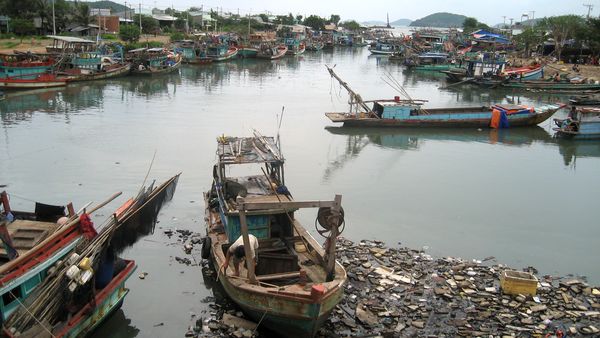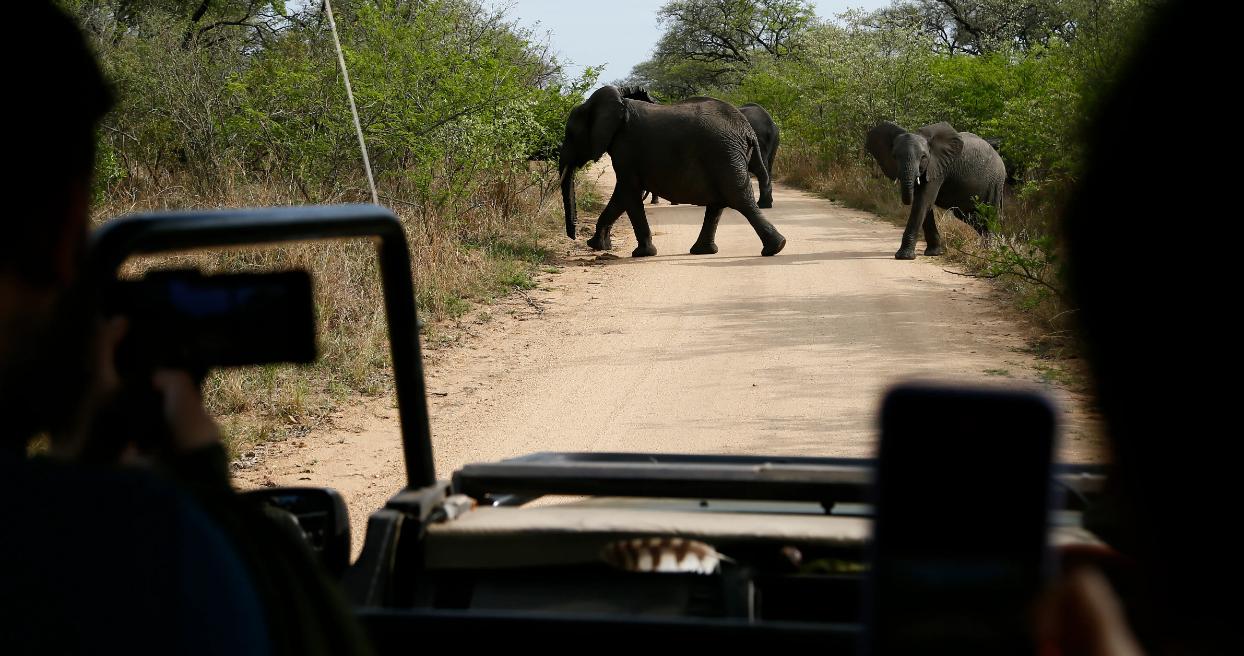Beijing, once among the most polluted cities globally, has significantly improved its air quality over the past two decades, with its experience possibly providing Hanoi with valuable insights into the severe air pollution that the Vietnamese capital is enduring.

Changing Tides for a Common Future: The MRC and Hydro-Diplomacy
(For PanNature’s Policy Review)
The Mekong River Commission (MRC), the only intergovernmental body mandated to sustainably manage and protect the Lower Mekong River, is on the brink of demise. While transboundary water governance has faced significant challenges in the region since the MRC was established in 1995, the Commission’s first real test came more recently with the start of the regional debate over plans to build a cascade of eleven mainstream dams on the Lower Mekong River. It was a test that the MRC has so far failed. The real question now, is will the MRC sink or swim? Just as the Mekong River ebbs and flows, can the MRC change the tide of decision-making to fit the urgent needs of a shared river basin where more than 60 million people are deeply dependent on the river functioning as it has for centuries: A key source of livelihoods, food security, and cultural identity?
While the future of the MRC depends on the will and leadership of its four member countries, the proposed Don Sahong Dam may be the opportunity that the MRC needs to change the discourse and improve hydro-diplomacy, in order to react and respond to the lessons of the past and make change for the future, before it is too late.

Sovereign Interests vs Transboundary Environmental Harm
As the world’s largest inland freshwater fishery and second most biodiverse river in the world, the Mekong River serves as the lifeblood for the region’s people. The river’s health depends on its connectivity and flood-drought cycles, which are vital for sustaining the river’s rich ecology, fisheries resources and a sediment and nutrient balance necessary for the region’s agricultural productivity. The accelerated push to build hydropower dams on the Lower Mekong’s mainstream currently dominates the MRC’s agenda and threatens its mandate of sustainably managing the river and its resources.
In 2010, the MRC published a Strategic Environmental Assessment (SEA) of the mainstream dams, which warned of the dams’ high risks to the region’s rich natural resources and people. The report further warned that many of the dams’ impacts would be irreversible and could not be effectively mitigated, and that the costs and benefits within and between countries would be extremely uneven. Furthermore, the report acknowledged that significant knowledge gaps continue to exist, which hinder the ability of the Mekong countries to assess the proposed projects within the basin and make informed decisions. Despite the report’s conclusion which recommended a ten year deferment on all decisions over the Mekong dams, politics won out over the needs of the Mekong River, as the Lao government quickly set the groundwork for dam-building by pushing forward with the first Mekong mainstream dam.
The Xayaburi Dam located in northern Laos was the first project to undergo the MRC’s Prior Consultation Process, which started in late 2010.The Prior Consultation process is required under the 1995 Mekong Agreement for planned projects on the mainstream of the Mekong River as a means for neighboring governments to evaluate the project with the aim of trying to reach agreement amongst all member countries over whether or not to build a project. As the Xayaburi Dam was the first project to undergo the Prior Consultation process, it proved to be the first real test for the MRC and the Procedures of the 1995 Mekong Agreement.
From the start, the process was plagued with problems. Construction towards the Xayaburi Dam occurred simultaneously to the project’s Prior Consultation process calling into question the objective of the procedure. Early on in the process, local and international civil society groups raised concerns over the Xayaburi Dam’s likely significant impacts to the region’s fisheries and sediment flows and the need for a ten year deferment in decision-making, as had been recommended by the MRC’s SEA report. Civil society groups also demanded a voice in the consultation process and that project specific documents be made publicly available in order to effectively understand and comment on the proposed project. The Cambodian and Vietnamese governments echoed similar concerns over the Xayaburi Dam’s transboundary impacts and the need for further study and consultation.
Yet, there was never an opportunity for further due diligence of the project and its transboundary impacts were simply ignored, as adequate baseline data was never collected nor was a transboundary impact assessment carried out for the project. Instead, the Lao government ploughed forward with the Xayaburi Dam’s preparatory work and agreement negotiations, while making unproven claims that the project would have no transboundary impacts as it was engineered to be sustainable and transparent.
As the MRC countriescould not reach agreement during the Special Joint Committee Meeting held in April 2012 to discuss the Xayaburi Dam, they agreed to raise the project to the ministerial level, the MRC’s Council. Three years later, sovereign interests have trumped regional cooperation, as the government of Laos continues to make no efforts to compromise on its position or to reach a mutually agreeable solution. As a result, the MRC Council has never reached a regional decision on how to proceed with the project and, according to developers; the dam is now 40% complete.
The Don Sahong Dam, the second Mekong mainstream dam, is now following similar course.
Playing Dominoes with the Don Sahong Dam
Located close to the Lao-Cambodian border at one of the worst places imaginable for a dam, the Don Sahong Dam threatens to wreak havoc on the Mekong fisheries and biodiversity should the project’s unproven mitigation measures fail. Despite the risks associated with the project and the dangers it poses to the region’s people, the project has become tangled in yet another diplomatic dispute. While Laos is hoping to proceed, the governments of Cambodia, Thailand and Vietnam have used the project’s Prior Consultation Process to express concern about the significant knowledge gaps which remain in understanding the full impacts of the Don Sahong Dam and have requested an extension to the process to allow for further studies and verification of the validity of its proposed mitigation measures.
As all four countrieswere unable to reach agreement on how to proceed when the Joint Committee met in January, the decision was deferred to ministerial level deliberations. In June, without any information as to when or how the MRC Council convened, the MRC announced it was unable to reach agreement as “there are still differing views among the countries on whether the prior consultation process should come to an end…” and that the discussion will be “referred to their respective governments for resolution.” From this announcement it remains unclear what the deliberation process at the governmental level will entail, who will be involved in each respective government, and what the timeline is for the process.
The news from the MRC has helped intensify regional concerns that adomino effect is now in play on the Mekong River, with the Don Sahong Dam beginning to follow the same trajectory asthe Xayaburi Dam’s Prior Consultation process in which consensus and agreement were never achieved.
In order to ensure that the concerns of neighboring countries’ are not swept under the rug yet again, the Mekong countries must demand that regional interests are placed at the forefront of future decision-making over the shared river. As the MRC remains the only institution mandated to ensure regional cooperation over the Mekong River, it’s time for the MRC to play its part in upholding the rights and concerns of all four countries by facilitating a true platform for regional decision-making to effectively take place.

One Step Back, Time for Six Steps Forward
By placing the Don Sahong Dam at the top of the agenda, the MRC has a chance to reinvent itself as the institution earlier envisioned by many in the region and regain its credibility. For this to happen, the following six measures must occur:
- Demand a Halt to the Don Sahong Dam: The MRC should first and foremost demand that all construction and project agreements towards the Don Sahong Dam be halted until the project’s Prior Consultation process reaches completion and that a regional agreement to construct the project is made by the four governments and its people. Sufficient time should be allowed for the completion of regional studies that are underway, including the MRC’s Council Study and Vietnam’s Mekong Delta Study, along withother studies, such as transboundary impact assessment which have been identified as important, to be carried out to fill critical knowledge gaps. The MRC should also clearly communicate a roadmap for future intergovernmental deliberations over the project to take place. This should include helping to facilitate a transparent and participatory platform for regional cooperation and decision-making, inclusive of the Mekong’s governments, affected people and other stakeholders, which will uphold the rights and concerns of all countries.
- Fortify Political Will: While the MRC countries reaffirmed their political will to cooperate over the shared river basin at the Second MRC Summit in April 2014, few measures have been taken since then to strengthen the MRC. In June, international donors to the MRC announced a series of changes that they expect to happen if they are to continue funding the institution, as they view financial self-reliance through member countries as a key indicator of ownership and sustainability. While the recommended changes are not the golden bullet to a new and improved MRC, they offer some solutions that will help lead to an improved strategic plan, clearer operational procedures and a better conceptual framework. International donors, including the Australian and Danish governments, have also provided the MRC with some useful guidance for improving the Prior Consultation procedures and process. Many of these reforms can easily be made if the MRC countries recognize the importance of a healthy river to their economies and people, and take the initiative to improve regional MRC cooperation and governance. Finally, international donors and MRC countriesmust take responsibility for holding the MRC accountable and for calling out members who fail to respect the spirit of the 1995 Mekong Agreement.
- Seek Proactive Institutional Leadership: The MRC Secretariat’s role is to support cooperation in the development and management of the Mekong River. As part of this role, the Secretariat is meant to help provide advice to the member countries, exchange ideas and information, coordinate research, and convene meetings to ensure that the four governments can meet and deliberate when needed. While there has been no CEO in place since February- as the four governments are unable to reach agreement over its first riparian leader- leadership within the Secretariathas been weak for years. The failure of the Secretariat to act when action is possible has compounded the existing problems of the MRC and regional cooperation.Rather than stepping back, as the Secretariat has done, the Don Sahong Dam should be used as an opportunity for the Secretariat to step up to their position. A CEO with water diplomacy skills should be hired and the Secretariat should work proactively and transparently to create and facilitate a platform for the inter-governmental diplomacy that its member countries need to ensure that bilateral and multilateral talks over the future of the Don Sahong Dam and its Prior Consultation process occur. While doing this, the Secretariat should communicate regarding the progress underwayand help fill the knowledge gaps that are needed for member countries to make their decisions.
- Fill Knowledge Gaps: For science to fulfill its role in allowing for informed decision making, it must be backed with good governance. The MRC with its body of experts can help stand at the forefront of ensuring that credible research is undertaken when needed throughout all stages of project planning and operation, the MRC’s SEA report alone lists more than 50 studies that are still needed to assess the impacts of the Mekong dams. Furthermore, the MRC can help facilitate independent verification on research produced by the host countries and dam developers and demand that the burden of proof – that the project will not harm the Mekong – lay on the developer. The key challenge that remains will be how the MRC identifies ways to ensure that the knowledge produced is then utilized within the decision-making process, so that politics are not prioritized over science.
- Reform Procedures for Clarity and Joint Decision-Making: The ambiguities of the 1995 Mekong Agreement have often been left for interpretation, allowing for the countries’ vested interests to define the rules of the game. However,procedural reform can help resolve the problems that have occurred in the dams’ Prior Consultation processes to date. Firstly, democratizing decision-making by providing a role for the public to have avoice in decision-making is essential. Informed consent by affected communities should be a key requirement prior to any project commencement. Secondly, the order of decision-making and the speed in which the MRC operates are problematic. As a step towards fixing these problems, project designs and studies must be made publicly accessible and no key decisions -including project agreements – should be made by member countries while critical research and MRC procedures are still underway. Finally, state responsibilities for ensuring joint decision-making must be clearly articulated within the Agreement and when in doubt, the MRC should bring in lawyers to resolve any questions that arise over the Agreement. Rather than just being a rough proxy for policy-making, the MRC should also develop a mechanism that allows the institution to have some teeth in terms of ensuring accountability and conflict resolution amongst the member governments.
- Guarantee “Good Faith” Cooperation: To balance the rights of upstream and downstream countries, the Mekong Agreement requires all four governments to make a “good faith” effort to reach agreement when cooperating on whether a project goes forward. Intergovernmental bargaining can only happen when upstream and downstream interests have a place in the decision-making process; when transboundary social, economic and environmental impacts are studied and fully accounted for in the project costs, and when countries are willing to consider regional needs over sovereign interests.
Regional differences can no longer overshadow the need for a healthy Mekong River. It’s time that the Mekong countries work together for a common future by recognizing and prioritizing the transboundary value of regional decision-making over the future of the river basin and its life sustaining natural resources. It’s time for the MRC to no longer be sidelined in Mekong hydro-diplomacy; by galvanizing the Don Sahong Dam’s Prior Consultation process to make the necessary changes to the MRC, the tide can still change before it’s too late for the Mekong River and her people.
By Ame Trandem
—————————————————————————————————————————————————————-
Ame Trandem, Southeast Asia Program Director at International Rivers, a non-governmental organization working to protect rivers and the rights of communities who depend upon them. The author’s writing reflects her own opinions and does not necessarily reflect the views of PanNature or the organization she’s working with.


